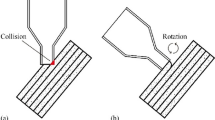Abstract
Ultra-precision machine errors are generally carried out by laser interferometer measurement preliminary, and then, judgment is further made by trial cutting parts. The applications are limited due to its high cost and the unavailable measurement data in the non-open source ultra-precision machines. Meanwhile, the machining parts are lack of an arithmetic that tells the main errors of the processing. This article first analyzes the specific forms of machine errors, and the model of geometric errors has been simplified based on the dynamics of multibody systems theory. On the basis of the coupling geometric errors, specific shapes are used to reverse calculate errors, and the result could predict the processing conditions in different free form surfaces. The accuracy of reverse calculation model is verified by experiments.
Similar content being viewed by others
References
Corbett J, McKeown P, Peggs G, Whatmore R (2000) Nanotechnology: international developments and emerging products. CIRP Ann Manuf Technol 49(2):523–545
Ramesh R, Mannan M, Poo A (2000) Error compensation in machine tools—a review: part I: geometric, cutting-force induced and fixture-dependent errors. Int J Mach Tools Manuf 40(9):1235–1256
Okafor AC, Ertekin YM (2000) Vertical machining center accuracy characterization using laser interferometer: part 1. Linear positional errors. J Mater Process Technol 105(3):394–406
Okafor AC, Ertekin YM (2000) Vertical machining center accuracy characterization using laser interferometer: part 2. Angular errors. J Mater Process Technol 105(3):407–420
Suh SH, Lee ES, Jung SY (1998) Error modelling and measurement for the rotary table of five-axis machine tools. Int J Adv Manuf Technol 14(9):656–663
Liu ZQ (1999) Repetitive measurement and compensation to improve workpiece machining accuracy. Int J Adv Manuf Technol 15(2):85–89
Kline WA, Shareef IA, DeVor RE (1982) The prediction of surface accuracy in end milling. J Eng Ind 104(3):272–278. doi:10.1115/1.3185830
Shabana AA (2005) Dynamics of multibody systems. Cambridge University Press, Cambridge
Yi A, Li L (2005) Design and fabrication of a microlens array by use of a slow tool servo. Opt Lett 30(13):1707–1709
Fang F, Zhang X, Hu X (2008) Cylindrical coordinate machining of optical freeform surfaces. Opt Express 16(10):7323–7329
Author information
Authors and Affiliations
Corresponding author
Rights and permissions
About this article
Cite this article
Gao, H., Fang, F. & Zhang, X. Reverse analysis on the geometric errors of ultra-precision machine. Int J Adv Manuf Technol 73, 1615–1624 (2014). https://doi.org/10.1007/s00170-014-5931-3
Received:
Accepted:
Published:
Issue Date:
DOI: https://doi.org/10.1007/s00170-014-5931-3




